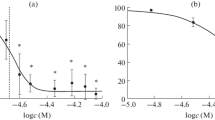Summary
-
1)
Polar pattern formation and morphogenesis during metamorphosis ofHydractinia echinata are pre-programmed by the spatial distribution of morphogenetic potencies along the body axis of the planula larva. This prepattern becomes manifest when parts of larvae are brought to metamorphosis immediately after isolation. The anterior region forms only stolons, the posterior only a head. The middle region can develop stolons as well as heads. The potencies for head and stolon formation establish gradients with opposite directions.
-
2)
The origin of this pattern during embryogenesis and its expression in the course of metamorphosis can be influenced by chemical stimuli. Two alternative effects can be obtained: activation of head formation at the expense of stolonal growth (=oralization); hyperdevelopment of stolon tissue at the expense of head structures (=aboralization).
-
3)
Caesium ions temporarily applied during cleavage result in larvae which complete metamorphosis with symptoms of aboralization. Cs+ ions applied during early metamorphosis (disc stage) exert an oralizing influence. The sensitive periods coincide with phases of high Na+−K+-ATPase activity. Ouabain abolishes the morphogenetic action of Cs+.
-
4)
Strong symptoms of oralization or aboralization can also be evoked by exposing disc stages to neuropharmacological agents. Acetylcholine (carbachol) brings about oralization; serotonin causes aboralization.
-
5)
In planulae a substance can already be traced which corresponds to the neurosecretory head activator known from adult organisms. Along with initiation of metamorphosis, head activator activity rises steeply and already approaches its final level in early metamorphosis. Activities extracted from metamorphosing larvae or various adult Cnidaria when applied to disc stages promote head formation without affecting stolonal growth. Dose response curves display optimum peaks.
-
6)
The significance of pre-programming and of neuroid functions in polarized patterning are discussed
Similar content being viewed by others
References
Beloussov, L.V.: Growth and morphogenesis of some marine Hydrozoa according to histological data and time-lapse studies. Publ. Seto Mar. Biol. Lab.20 (Proc. Second Internat. Symp. Cnidaria), 315–366 (1973)
Campbell, R.D.: Development. In: Coelenterate Biology (L. Muscatine and H.M. Lenhoff, eds.), pp. 179–210, New York: Acad. Press 1974
Gierer, A., Berking, S., Bode, H., David, C.N., Flick, K., Hansmann, G., Schaller, H., Trenkner, E.: Regeneration of hydra from reaggregated cells. Nature, New Biology239, 98–101 (1972)
Gierer, A., Meinhardt, H.: A theory of biological pattern formation. Kybernetik12, 30–39 (1972)
Hauenschild, C.: Genetische und entwicklungsphysiologische Untersuchungen über Intersexualität und Gewebeverträglichkeit beiHydractinia echinata. Wilhelm Roux' Archiv147, 1–31 (1954)
Ivker, F.B.: A hierarchy of histo-incompatibility inHydractinia echinata. Biol. Bull. (Woods Hole)143, 162–174 (1972)
Lesh-Laurie, G.E.: Expression and maintenance of organismic polarity. In: Biology of Hydra (A.L. Burnett, ed.), pp. 143–168, New York, London: Acad. Press 1973
May, G., Müller, W.A.: Aktivitäten von Enzymen des Kohlenhydrat-Stoffwechsels und der Na+−K+-ATPase im Zuge der Embryonalentwicklung und Metamorphose vonHydractinia echinata (Hydrozoa). Wilhelm Roux's Archives177, 235–254 (1975)
Mergner, H.: Cnidaria, In: Experimental embryology of marine and fresh-water invertebrates (G. Reverberi, ed.), pp. 1–84, Amsterdam: North-Holland Publ. Co. 1971
Müller, W.A.: Experimentelle Untersuchungen über Stockentwicklung, Polypendifferenzierung und Sexualchimaeren beiHydractinia echinata. Wilhelm Roux' Archiv155, 181–268 (1964)
Müller, W.A.: Die Steuerung des morphogenetischen Fließgleichgewichts in den Polypen vonHydractinia echinata. I. Biologisch-experimentelle Untersuchungen. Wilhelm Roux' Archiv163, 334–356 (1969a); II. Chemisch-analytische Untersuchungen. Wilhelm Roux' Archiv163, 357–374 (1969b)
Müller, W.A.: Metamorphose-Induktion bei Planulalarven. I. Der bakterielle Induktor. Wilhelm Roux' Archiv173, 107–121 (1973)
Müller, W.A.:Hydractinia echinata (Hydrozoa): Ablaichen, Embryonalentwicklung, Metamorphose. Göttingen: Film E 2080 des Inst. Wiss. Film (1975a)
Müller, W.A.: Polarität und Gradienten in der Morphogenese der Hydrozoen. Verh. Dtsch. Zool. Ges. 1974, 99–107, Stuttgart: G. Fischer-Verlag 1975b
Müller, W.A., Buchal, G.: Metamorphose-Induktion bei Planulalarven. II. Induktion durch monovalente Kationen. Wilhelm Roux' Archiv173, 122–135 (1973)
Müller, W.A., Spindler, K.-D.: The “polarizing inducer” in hydra: A reexamination of its properties and its origin. Wilhelm Roux' Archiv167, 325–335 (1971)
Müller, W.A., Spindler, K.-D.: The effects of sulphydryl-reagents on morphogenesis in hydroids. Wilhelm Roux' Archiv170, 152–164 (1972)
Müller, W.A., Wieker, F., Eiben, R.: Larval adhesion, releasing stimuli and metamorphosis. In: Coelenterates: their Ecology and Behaviour (Third Intern. Symp. Coelenterate Biol.), New York: Plenum Publ. Co. 1976
Schaller, H.Ch.: Isolation and characterization of a low-molecular-weight substance activating head and bud formation in hydra. J. Embryol. exp. Morphol.29, 27–38 (1973)
Schaller, H.Ch.: A neurohormone from hydra is also present in the rat brain. J. Neurochemistry25, 187–188 (1975)
Schaller, H.Ch.: Action of the head activator as a growth hormone in hydra. Cell Differentiation5, 1–11 (1976)
Schaller, H.Ch.: Action of the head activator on the determination of interstitial cells in hydra. Cell Differentiation5, 13–20 (1976)
Schaller, H.Ch., Gierer, A.: Distribution of the head-activating substance in hydra and its localization in membranous particles in nerve cells. J. Embryol. exp. Morphol.29, 39–52 (1973)
Spindler, K.-D., Müller, W.A.: Induction of metamorphosis by bacteria and by a lithium-pulse in the larvae ofHydractinia echinata (Hydrozoa). Wilhelm Roux' Archiv169, 271–280 (1972)
Van de Vyver, G.: Etude histologique du développement d'Hydractinia echinata (Flem.). Cahiers de Biol. Mar.5, 295–310 (1964)
Van de Vyver, G.: Etude du développement embryonnaire des hydraires athécates (gymnoblastiques) à gonophores. I. Formes à planula. Arch. Biol. (Liège)78, 451–518 (1967)
Webster, G.: Morphogenesis and pattern formation in hydroids. Biol. Review46, 1–46 (1971)
Wolpert, L.: Positional information and pattern formation. Current Topics Develop. Biol.6, 183–224 (1971)
Wolpert, L., Hornbruch, A., Clarke, M.R.B.: Positional information and positional signalling in hydra. Am. Zool.14, 647–654 (1974)
Wyttenbach, Ch.R.: Cell movements associated with terminal growth in colonial hydroids. Am. Zool.14, 677–717 (1974)
Author information
Authors and Affiliations
Additional information
Supported by the Deutsche Forschungsgemeinschaft
Rights and permissions
About this article
Cite this article
Müller, W.A., Mitze, A., Wickhorst, JP. et al. Polar morphogenesis in early hydroid development: Action of caesium, of neurotransmitters and of an intrinsic head activator on pattern formation. Wilhelm Roux' Archiv 182, 311–328 (1977). https://doi.org/10.1007/BF00848383
Received:
Accepted:
Issue Date:
DOI: https://doi.org/10.1007/BF00848383




